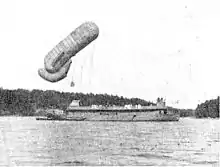

A balloon carrier or balloon tender was a ship equipped with a balloon, usually tied to the ship by a rope or cable, and usually used for observation. During the second half of the 19th century and the early 20th century, these ships were built to have the furthest possible view of the surrounding waters. After several experiments, the type became formalized in the early 1900s, but was soon to be superseded by the development of seaplane carriers and regular aircraft carriers at the beginning of World War I.
Early history
In 1849 the Austro-Hungarian naval ship SMS Vulcano took part in the first aggressive use of balloons in warfare,[1][2] serving as a balloon carrier (the precursor to the aircraft carrier)[3] in the first offensive use of air power in naval aviation.[4][5][6] Austrian forces besieging Venice attempted to float some 200 paper hot air balloons, each carrying a 24- to 30-pound bomb that was to be dropped from the balloon with a time fuse over the besieged city. The balloons were launched mainly from land; however, some were also launched from Vulcano. The Austrians used smaller pilot balloons to determine the correct fuse settings. At least one bomb fell in the city; however, due to the wind changing after launch, most of the balloons missed their target, and some drifted back over Austrian lines and the launching ship Vulcano.[7][8][9]
Later, during the American Civil War, about the time of the Peninsula Campaign, gas-filled balloons were being used to perform reconnaissance on Confederate positions. The battles turned inland into the heavily forested areas of the Virginia Peninsula where balloons could not travel. A coal barge, the George Washington Parke Custis, was cleared of all deck rigging to accommodate the gas generators and apparatus of balloons. From this ship, professor Thaddeus S. C. Lowe, Chief Aeronaut of the Union Army Balloon Corps, made his first ascents over the Potomac River and telegraphed claims of his successful aerial venture. Other barges were converted to assist with the other military balloons transported about the eastern waterways. None of these Civil War craft ever sailed on the high seas. A Confederate balloon carrier, the CSS Teaser, was in service from 1861 to 1862 before being captured by the Union Navy.
In 1913 the Spanish engineer Leonardo Torres Quevedo designed a new type of boat called "Camp-Vessel", to transport dirigible balloons attached to a mooring post. He offered the patent to the British Army, but the project was dismissed.[10][11]
Types
_(en_1922).svg.png.webp)
Balloons launched from ships led to the formal development of balloon carriers, or balloon tenders, during World War I, by the navies of Great Britain, France, Germany, Italy, Russia, and Sweden. About 10 such balloon tenders were built with their main objective being aerial observation posts. These ships were either decommissioned or converted to seaplane tenders after the War.[12]
See also
References
- ↑ John Buckley (2006). Air Power in the Age of Total War. Routledge. p. 43. ISBN 978-1-135-36275-1.
- ↑ Alan McKenna (2016). The Future of Drone Use: Opportunities and Threats from Ethical and Legal Perspectives. Springer. p. 355. ISBN 978-94-6265-132-6.
- ↑ Philip Kaplan (2013). Naval Aviation in the Second World War. Pen and Sword. p. 19. ISBN 978-1-4738-2997-8.
- ↑ Richard P. Hallion (2003). Taking Flight: Inventing the Aerial Age, from Antiquity through the First World War. Oxford University Press. p. 66. ISBN 978-0-19-028959-1.
- ↑ R. D. Layman (1996). Naval Aviation in the First World War: Its Impact and Influence. Naval Institute Press. p. 56. ISBN 978-1-55750-617-7.
- ↑ Stephen L. Renner (2016). Broken Wings: The Hungarian Air Force, 1918-45. Indiana University Press. p. 2. ISBN 978-0-253-02339-1.
- ↑ Justin D. Murphy (2005). Military Aircraft, Origins to 1918: An Illustrated History of Their Impact. ABC-CLIO. pp. 9–10. ISBN 978-1-85109-488-2.
- ↑ F. Stansbury Haydon (2000). Military Ballooning During the Early Civil War. The Johns Hopkins University Press. pp. 18–20. ISBN 978-0-8018-6442-1.
- ↑ Mikesh, Robert C. "Japan's World War II balloon bomb attacks on North America." (1973).
- ↑ Patentes de invención de Don Leonardo Torres Quevedo, España Registro de la Propiedad Industrial, 1988. ISBN 84-86857-50-3
- ↑ Francisco A. González Redondo. Airships on board: the history of the 'Airships Carrier', 1913-1922, pp.116-122, Flights of Fact and Fantasy, 2018.
- ↑ "Sandcastle V.I. - Carriers: Airpower at Sea - The Early Years / Part 1". sandcastlevi.com.